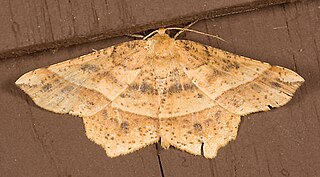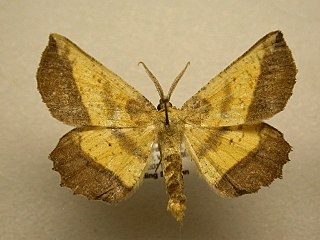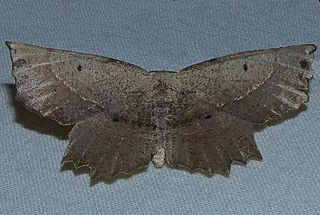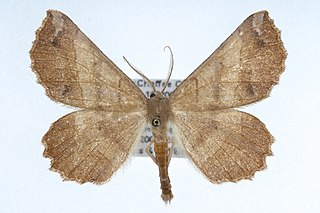
Lepidoptera or lepidopterans is an order of winged insects that includes butterflies and moths. About 180,000 species of the Lepidoptera have been described, representing 10% of the total described species of living organisms, making it the second largest insect order with 126 families and 46 superfamilies. and one of the most widespread and widely recognizable insect orders in the world.

Moths are a group of insects that includes all members of the order Lepidoptera that are not butterflies. They were previously classified as suborder Heterocera, but the group is paraphyletic with respect to butterflies and neither subordinate taxa are used in modern classifications. Moths make up the vast majority of the order. There are thought to be approximately 160,000 species of moth, many of which have yet to be described. Most species of moth are nocturnal, although there are also crepuscular and diurnal species.

The Arctiinae are a large and diverse subfamily of moths with around 11,000 species found all over the world, including 6,000 neotropical species. This subfamily includes the groups commonly known as tiger moths, which usually have bright colours, footmen, which are usually much drabber, lichen moths, and wasp moths. Many species have "hairy" caterpillars that are popularly known as woolly bears or woolly worms. The scientific name Arctiinae refers to this hairiness. Some species within the Arctiinae have the word "tussock"' in their common names because they have been misidentified as members of the Lymantriinae subfamily based on the characteristics of the larvae.

The Pyralidae, commonly called pyralid moths, snout moths or grass moths, are a family of Lepidoptera in the ditrysian superfamily Pyraloidea. In many classifications, the grass moths (Crambidae) are included in the Pyralidae as a subfamily, making the combined group one of the largest families in the Lepidoptera. The latest review by Eugene G. Munroe and Maria Alma Solis retain the Crambidae as a full family of Pyraloidea.

The Angeronini are a small tribe of geometer moths in the subfamily Ennominae. The tribe was first described by William Trowbridge Merrifield Forbes in 1948. As numerous ennomine genera have not yet been assigned to a tribe, the genus list is preliminary.

Euchlaena is a genus of moths in the family Geometridae erected by Jacob Hübner in 1823.

Euchlaena tigrinaria, the mottled euchlaena, is a moth of the family Geometridae. The species was first described by Achille Guenée in 1857. It is found from New Brunswick to Virginia, west to Texas, Utah and Oregon, north to British Columbia.

Euchlaena amoenaria, the deep yellow euchlaena, is a moth of the family Geometridae. It is found in eastern North America.

The Erebidae are a family of moths in the superfamily Noctuoidea. The family is among the largest families of moths by species count and contains a wide variety of well-known macromoth groups. The family includes the underwings (Catocala); litter moths (Herminiinae); tiger, lichen, and wasp moths (Arctiinae); tussock moths (Lymantriinae), including the arctic woolly bear moth ; piercing moths ; micronoctuoid moths (Micronoctuini); snout moths (Hypeninae); and zales, though many of these common names can also refer to moths outside the Erebidae. Some of the erebid moths are called owlets.

Euchlaena serrata, the saw-wing moth, is a species of moth of the family Geometridae. It is found in eastern North America.

Euchlaena obtusaria, the obtuse euchlaena moth, is a moth of the family Geometridae. The species was first described by Jacob Hübner in 1813. It is found in North America, where it has been recorded from Alberta east to Nova Scotia, south to Florida and Texas. The habitat consists of mixed wood forests.

Euchlaena deplanaria is a species of moth of the family Geometridae. It is found in North America, where it has been recorded from Colorado to Massachusetts and south to Florida and Texas.

Euchlaena marginaria, the ochre euchlaena moth, is a moth of the family Geometridae. The species was first described by Charles Sedgwick Minot in 1869. It is found in North America, where it has been recorded from south-central British Columbia and Idaho to Nova Scotia and south to Florida and Missouri. The habitat consists of mixed wood and deciduous forests.

Euchlaena deductaria, the forked euchlaena moth, is a species of moth of the family Geometridae. It is found in North America, where it has been recorded from Alabama, Arkansas, Florida, Georgia, Kentucky, Maine, Maryland, New York, North Carolina, Ohio, Oklahoma, South Carolina, Tennessee, Texas and West Virginia.

Euchlaena muzaria, the muzaria euchlaena moth, is a species of moth of the family Geometridae. It is found in North America, where it has been recorded from Florida, Kentucky, Maine, Maryland, Massachusetts, Minnesota, New Brunswick, New Hampshire, New York, North Carolina, Ohio, Ontario, South Carolina and Tennessee.

Euchlaena johnsonaria, or Johnson's euchlaena moth, is a moth of the family Geometridae. The species was first described by Asa Fitch in 1870. It is found in North America, where it has been recorded from southern coastal British Columbia east to Nova Scotia, south to New Jersey, Missouri and Oregon. The habitat consists of deciduous wooded areas.

Euchlaena madusaria, the scrub euchlaena moth, is a species of moth of the family Geometridae. It is found in North America, where it has been recorded from British Columbia, east to Nova Scotia, south to Florida, Missouri and Oregon. The habitat consists of dry woodlands. The species is listed as threatened in Connecticut.

Euchlaena mollisaria is a species of moth of the family Geometridae. It is found in North America, where it has been recorded from southern California to Colorado, north to Montana and British Columbia.
















